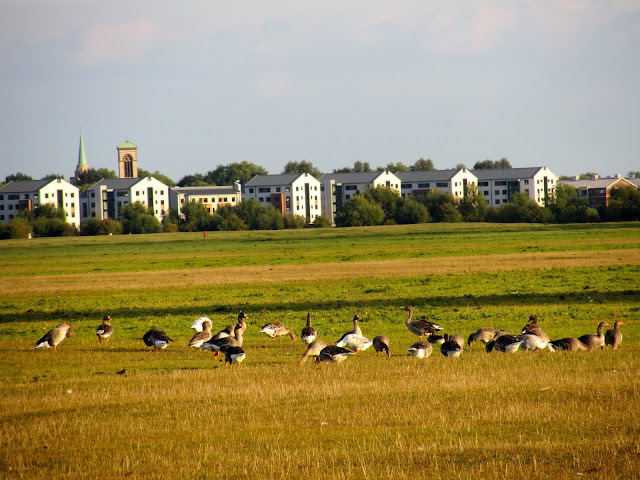On the North West edge of Oxford is Port Meadow, an area of grazing land that has been used for horses and cattle for at about 3000 years. The land has never been ploughed or been treated with any fertilizer or pesticide. So historically and scientifically, it is of great interest to the community.
Alfred the Great, who technically founded Oxford on the 10th century, gave the 300 acres of pasture next to the River Thames to the Freemen of Oxford in return for their help with defending the kingdom against the marauding Danes. The Freemen's collective right to graze their animals free of charge is recorded in the Doomsday Book of 1086 (the first official census of England) and has been exercised ever since. The grazing rights belong to the homes that surround the meadow to this day.
Last week, as part of the Oxford Open Door weekend, John and I signed up for a guided walk of Port Meadow with an archeologist as our guide. We learned that because the meadow has never been ploughed, it contains well-preserved archaeological remains, some of which survive as residual earthworks.
There are several round barrows that are what remains of Iron and Bronze Age dwellings. They are left over foundations made from centuries of turf layered upon turf, where dwellings from the Bronze and Iron Age once stood. They are two to three thousand-year-old-scars right under our feet and all the times I’ve walked on Port Meadow, I never noticed them until they were pointed out to me by our guide.
There are also the faint remains of the foundations of 16th-century horse racing track and low stone bridges laid over washes and ditches for this purpose survive to this day.

During World War One, part of Port Meadow was used as a military airfield and you can still see the outline of the grass airfield and where the temporary bunkers were. In WWII the Royal Artillery had a camp was set up on the meadow for military personnel evacuated from Dunkirk.
Cattle and horses still graze on the land. Our guide said that if animals stopped grazing, this land would tun into forest within a generation.
These apartments on the edge of the meadow are hugely controversial. They are new student housing (just opening this month) that the university built without going through the proper channel of Oxford City Council Planning, who would never have let them be built because they completely destroy the view of the city from the meadow.
Port Meadow is a typical English flood-meadow and and is a favorite area for walking since it is right on the edge of the city. Sometimes in the winter the meadow floods and, if frozen, forms a huge area for ice-skating. The first time I saw Port Meadow, it was late winter and the meadow was a lake -- completely flooded by the Thames. It looked like a lake on the edge of the city and I wondered why I never knew Oxford had a lake!
I am going to start paying more attention the the scars beneath my feet, especially here in Oxfordshire.
Today Port Meadow is still peaceful grazing land, much as it was 1000 year-ago, minus the marauding Danes. They have been replaced with students, rowing crews, and walkers like me.
Comments and corrections are always welcome!











Hey Shelley! It's Julianne : ) I found your blog! Hurrah! Toni's dad was in town this week, and we took him on our long walk starting here at Folly Bridge, along the river and up through Port Meadow to the Trout. SO fun and gorgeous. One of my favourite places in Oxford by far. The Thames River Walk up to it is particularly perfect - have you done that path? We should do it sometime! Glad you're back around and see you tomorrow!
ReplyDelete